
Duck Quacking Explained
When you hear your duck quacking, it’s more than just a charming background noise—it’s a vital form of communication. Ducks use their quacks to convey different emotions, warn their flockmates, and even chat just for the sake of it. But how exactly are these sounds created, and what are they trying to say?
The Biology Behind a Duck’s Quack
A duck’s quack originates from its syrinx, a vocal organ unique to birds. Located at the base of the trachea (windpipe), the syrinx has two sound-producing chambers, allowing ducks to create a wide range of sounds. Air flows through the syrinx, vibrating the membranes inside it, which produces the iconic quack we all know and love. The tightness of these membranes, the speed of airflow, and the shape of the trachea can all influence the pitch and volume of a duck’s quack.

Ducks also rely on resonance chambers within their beaks and throats to amplify these sounds. This is why some ducks sound louder than others and also why female ducks, in particular, tend to have a more pronounced and powerful quack.
Ducklings: Their Voices and Early Communication
Even from a young age, ducks are chatty! Ducklings use soft peeps and chirps to communicate with their mother and each other. These sounds are high-pitched and delicate, helping them stay in contact with the flock. Ducklings will often use a soft peep to signal that they’re content, while more urgent, rapid chirps can indicate they’re cold, hungry, or in need of attention.
As ducklings grow, their voices gradually change, and you’ll begin to hear the first hints of their adult quacks. By around 6 to 8 weeks, you’ll notice the difference between male and female voices beginning to emerge, with females becoming louder and more distinct.
Male vs. Female Duck Quacking: What’s the Difference?
One of the easiest ways to distinguish between male and female ducks is by their quacks. Female ducks are the ones responsible for the loud, classic quack sound that most people are familiar with. In contrast, male ducks, known as drakes, have a much quieter, more raspy voice. Drakes rarely quack like females; instead, they often make a soft rasping sound or a low-pitched grumble.
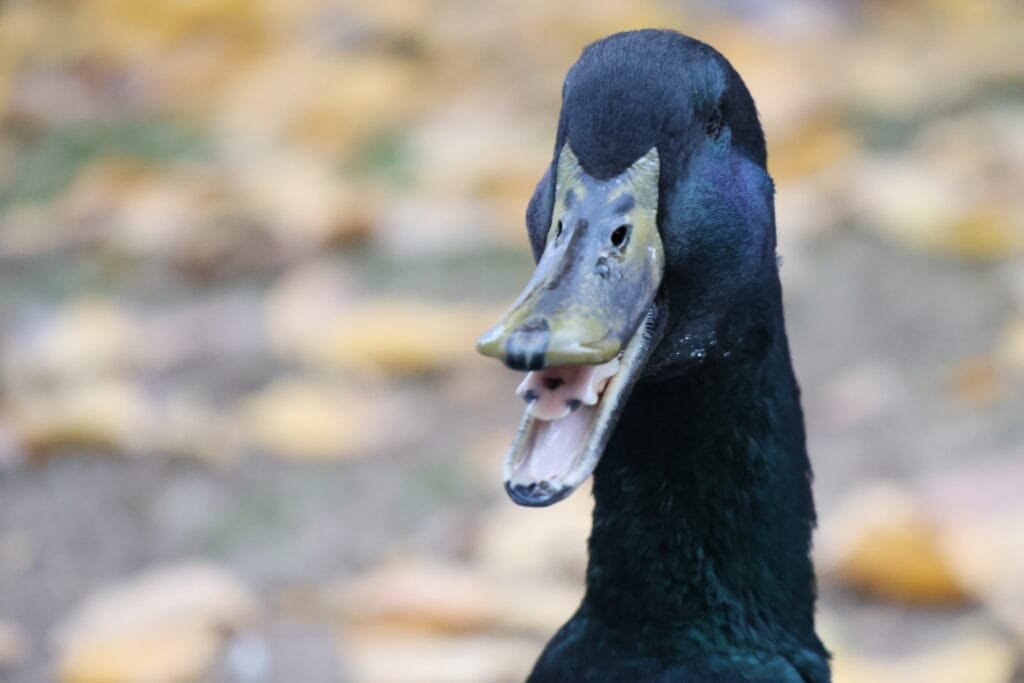
This difference in quacking is due to the size and structure of their syrinx. Female ducks generally have larger syrinxes, enabling them to create louder and more varied sounds. These vocal differences play an essential role in flock communication, especially during the breeding season when females use their calls to communicate with their mates and signal other ducks.
➡️ Read about other differences between male and female ducks.
Understanding the Variety of Female Duck Sounds
Female ducks are not only louder but also more vocal than their male counterparts. They produce a variety of quacks and other sounds depending on their mood, environment, and social interactions. Let’s explore some of the most common sounds female ducks make and what they mean.
1. Chatty Quacks
Female ducks are often talkative, especially when they’re content and socializing with other ducks. These quacks are short, repetitive, and soft, almost like casual “duck chit-chat.” You might hear them when your ducks are foraging together, grooming, or just lounging around. These chatty quacks serve as a way for ducks to stay in touch with one another while keeping the flock’s harmony intact.
2. Excited Quacking
If you’ve ever heard your ducks quacking frantically when they see you coming with treats, you’ve experienced excited quacking! These quacks are rapid, high-pitched, and full of energy. Ducks often quack excitedly when they’re anticipating something enjoyable, like food or playtime in the water. It’s a sure sign of positive emotions and excitement.
➡️ Read more about healthy treats for ducks.
3. The Egg Song
Female ducks have a special quack known as the egg song, which they make while laying an egg. This quack is loud, rhythmic, and repetitive, almost as if they’re announcing their accomplishment to the world! Some people describe the egg song as a proud “quack, quack, quack-quack-quack!” It’s also a way to let their flockmates know they’ve completed the laying process and are ready to rejoin the group.
4. Happy Foraging Quacks
When ducks are out foraging and finding delicious bits of food, you may hear what I like to call the happy foraging quack. This sound is more subdued than the excited quacks but is still lively and upbeat. It’s usually a series of quiet, low-pitched quacks made while they dabble and search for insects, seeds, or other tasty treats. It’s a way of expressing contentment while they’re engaged in one of their favorite activities—eating!
5. Afraid or Warning Calls
Quacks can also serve as alarm calls, alerting the rest of the flock to danger. When a female duck is frightened or senses a threat, she will let out a loud, sharp, and repetitive quack. These warning calls are intended to signal to the other ducks that there’s a predator nearby, whether it’s a stray dog, a hawk, or another potential threat. The quacking will become more frantic and intense as the danger approaches, and may even attract the attention of humans or other animals.
In some cases, ducks will even switch to a hiss or soft growl if they feel cornered or are trying to warn off an immediate danger. This is their way of communicating fear or distress in the hopes that their flock or caretakers will help.
6. Courtship Quacks: Love is in the Air
During mating season, ducks become much more vocal, using specific courtship quacks as part of their pairing rituals. These vocalizations are often subtle, but they play a key role in the ducks’ ability to form bonds and attract mates. In the world of ducks, males (drakes) and females use different types of sounds to communicate their interest in each other and engage in the complex process of courtship.
Female Courtship Calls
While female ducks are generally louder than males, during mating season, they can soften their quacks to become more rhythmic and repetitive as a signal of receptiveness. These quacks are not as loud as their excited or warning quacks but are instead part of a “conversation” with the male duck. This back-and-forth vocal exchange helps build trust and signals her willingness to pair up.
Male Courtship Displays and Quacks
Male ducks, on the other hand, engage in quieter, raspy quacks, often combined with elaborate physical displays. These courtship calls are meant to grab the attention of a female, showing off their strength and fitness. Along with their quacking, drakes will often bob their heads, fluff their feathers, and sometimes emit low-pitched whistles or grunts, all designed to impress potential mates.
The timing and rhythm of these sounds are crucial for ducks during the breeding season, as they signal readiness to mate and help solidify the bond between a pair. In some species, this vocal interaction continues even after pair formation, reinforcing the bond between mates.
Post-Mating Quacks
After mating, you might hear a short series of quacks from the female duck—similar to the egg song quacks but often less intense. These post-mating vocalizations could be seen as a signal to the rest of the flock, letting them know that pairing has taken place. It’s a fascinating reminder that quacking is more than just sound; it’s a tool for communication during one of the most important times of a duck’s life.
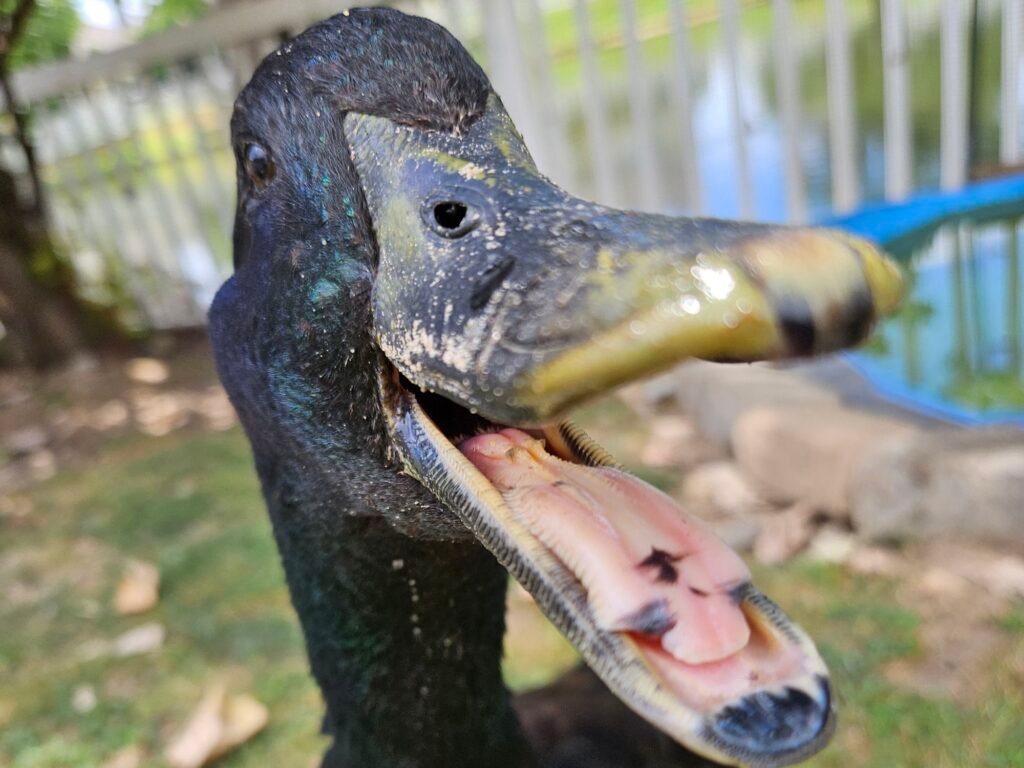
7. Territorial or Dominance Quacks: Quacking for Control
Ducks, despite their often easy-going appearance, have a well-established hierarchy within their flocks, and quacking plays a major role in maintaining order. These territorial or dominance quacks are most often heard during disputes over resources, such as food, water, or nesting areas, and are especially common when new ducks are introduced to an established flock.
Establishing Hierarchy
Ducks are social animals, but their flocks operate under a pecking order where certain individuals are dominant over others. Vocalizations are key in asserting this dominance, with louder and more aggressive quacks often being used to ward off rivals or assert control over a particular area. You might notice that when a more dominant duck enters a space, her quacks are deeper and more forceful, signaling to other ducks to back off.
These quacks can also be a way to assert dominance over newcomers. When introducing new ducks into your flock, you’ll likely hear louder, more aggressive quacks from the established ducks, especially the females. This vocal intimidation is part of how they defend their place in the pecking order and ensure the newcomers know where they stand.
Quacking and Aggression
During the breeding season, both males and females may become more territorial, and their quacks reflect this. If two ducks are vying for the same space or resource, you’ll often hear a sharp, aggressive quacking match between them. These aggressive quacks are typically loud and repetitive, accompanied by posturing, chasing, or even light pecking. In most cases, these disputes are resolved without physical fights, as the quacking alone is often enough to settle the issue.
Defending Nests and Territory
Ducks may also use territorial quacks to defend their nests. Female ducks, especially when nesting or brooding, can become highly protective of their space. They’ll often use loud, angry quacks to ward off other ducks or potential intruders. These defensive quacks signal to others that they are not to be disturbed, especially as they prepare to lay or incubate their eggs.
Interestingly, these aggressive quacks are more common in domestic ducks that are kept in smaller, enclosed spaces, where resources and nesting spots may be more limited. In larger, free-ranging environments, ducks are often able to spread out more, resulting in fewer vocal territorial disputes.
8. Energetic Quacks: The Call for Attention
Ducks are expressive creatures, and one of their most noticeable behaviors is the energetic quack they make when they want something—most commonly food or water. These quacks are characterized by their high pitch and urgency, signaling a clear need that can’t be ignored!
The Quack of Desire
When ducks become aware of the availability of food, whether it’s during feeding time or when they spot a tasty treat, they often erupt into a chorus of energetic quacks. This vocalization is much more animated and intense compared to their usual quacks. It can sound almost like a plea, with rapid-fire repetition that conveys excitement and anticipation. You may notice that all the ducks join in, creating a lively and cacophonous call that draws everyone’s attention. This urgent quack serves as a signal not only to their flock mates but also as a request to their human caretakers, letting you know that it’s time to bring them food.
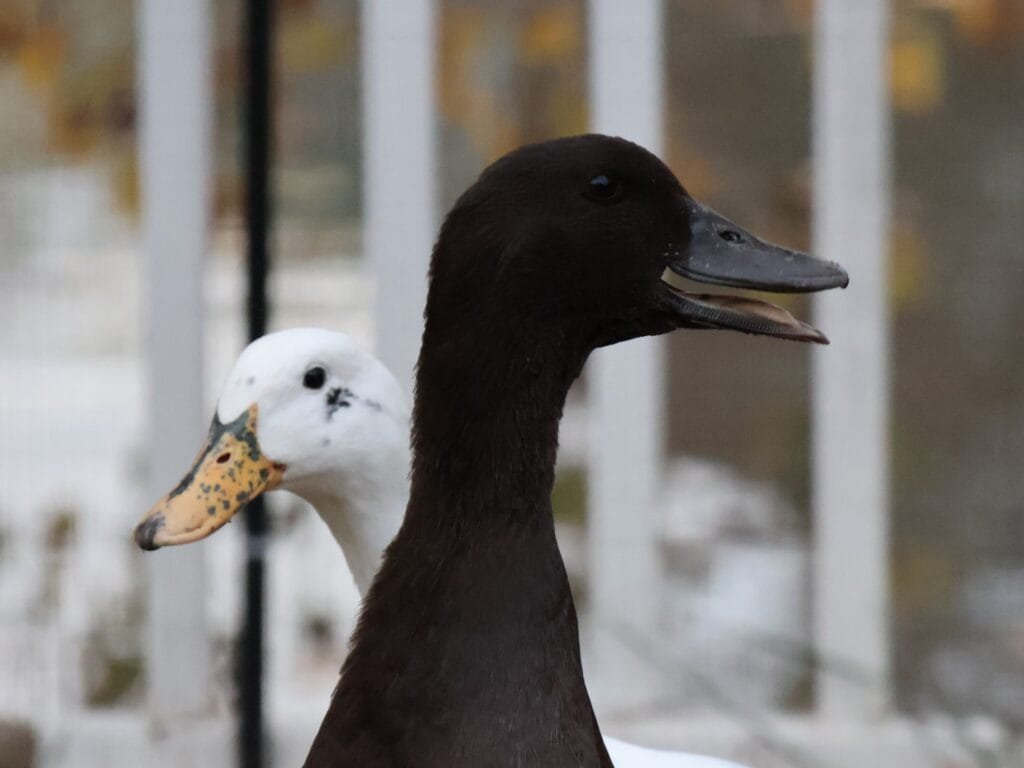
Communicating with the Flock
These energetic quacks serve not only to express individual desires but also to communicate with the entire flock. When one duck starts quacking energetically for food, others often respond in kind, creating a ripple effect that can turn a quiet gathering into a boisterous feeding frenzy. It’s a form of social interaction where the excitement of one duck can quickly become the excitement of many, emphasizing the communal aspect of feeding.
Encouraging Interaction
If you’ve ever watched your ducks during feeding time, you’ll likely recognize the familiar scene: as soon as you approach with food, they’ll start quacking energetically, eagerly clamoring for your attention. This lively quack is their way of encouraging interaction, and it’s hard not to respond when they express their needs so vocally! And as soon as they start eating, they go quiet and enjoy their food. It’s a delightful reminder of their personalities and their keen understanding of how to communicate their desires.
The Importance of Responsive Care
Understanding these energetic quacks is vital for any duck parent. Recognizing when your ducks are quacking out of hunger or thirst allows you to respond promptly, ensuring they remain happy and healthy. By paying attention to these vocal cues, you can foster a more responsive and nurturing environment for your flock, reinforcing the bond you share.
Every Duck Has a Unique Voice: Can You Tell Them Apart?
Did you know that each duck has its own unique quack? Just like humans have distinct voices, ducks’ vocalizations vary slightly between individuals. If you listen closely, experienced duck parents can often recognize the difference in tone, pitch, and rhythm between their ducks’ quacks. Some ducks may have higher-pitched voices, while others sound more gravelly or deep.
Can you tell the difference between your ducks’ quacks? Which one of your ducks is the loudest or the most chatty? Pay close attention, and you might be surprised at how distinctive each quack really is!
Duck Dialects: Do Ducks Speak Different “Languages”?
Ducks, especially those living in different regions, may develop slight variations in their quacking patterns, often referred to as duck dialects. While the core sounds remain the same, ducks raised in different environments or by different species may adapt their vocalizations slightly to fit in with the social dynamics of their flock. This is particularly noticeable in large ponds or wild populations where ducks from various backgrounds mingle.
Some research suggests that wild ducks raised in different habitats can develop distinct “accents,” much like humans do when they grow up in different places. These slight variations help ducks communicate more effectively within their specific groups. If you have a mixed flock, you might even notice subtle differences in how they communicate compared to when they interact with wild ducks!
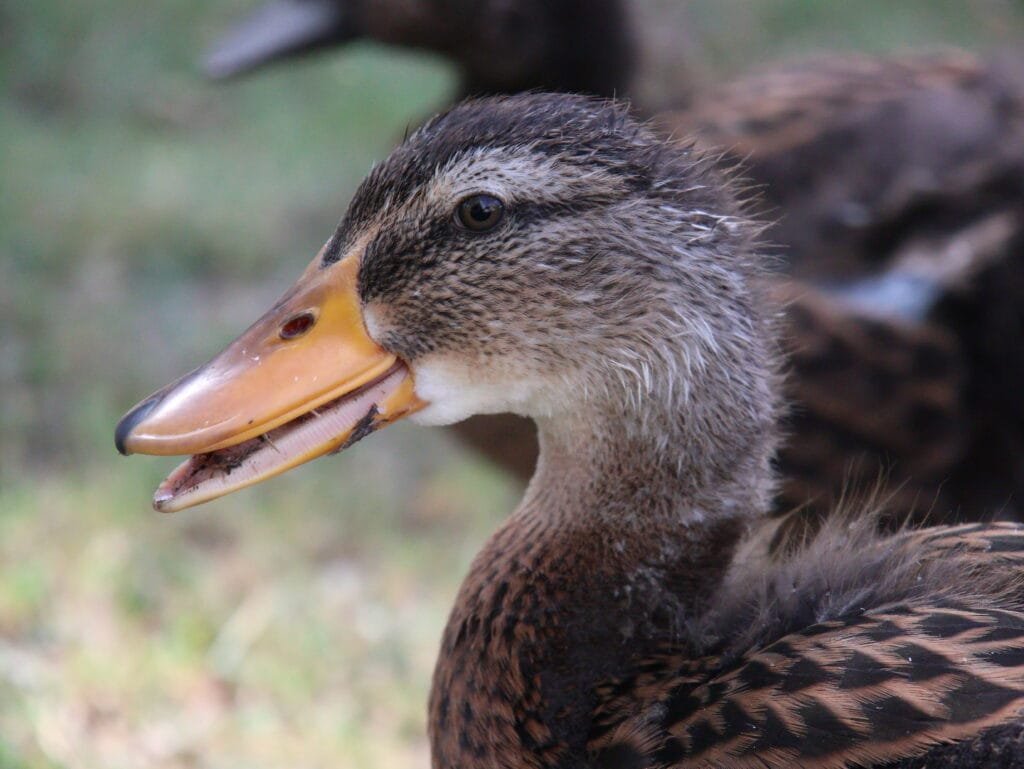
Communication Between Mother Ducks and Their Babies
Mother ducks have a special bond with their ducklings and communicate with them constantly. One of the most heartwarming sounds is the soft quack or cooing noise a mother duck makes to reassure her babies and guide them. These sounds are gentle and repetitive, helping the ducklings stay close to her as they learn to navigate their environment.
When she senses danger, the mother duck will make urgent warning quacks, prompting the ducklings to freeze or hide for safety. On the flip side, she may also use low, encouraging sounds to signal that it’s time to move or follow her to a new area. Ducklings, in turn, respond with their own peeps and chirps to acknowledge her and let her know they are nearby.
Do Quacks Echo?
There’s a long-standing myth that duck quacks don’t echo, which has been perpetuated through jokes and anecdotes. But let’s dive into the science and clarify this misconception!
The truth is that duck quacks do echo. Sound, including quacking, is produced by vibrations that travel through the air and bounce off surfaces, creating an echo. The notion that duck quacks don’t echo may stem from the way we perceive the sound in certain environments. For instance, when ducks quack in wide open spaces—like lakes or fields—the sound may dissipate quickly, making it less noticeable. Conversely, if ducks quack in an area with plenty of hard surfaces, such as near buildings or rocky terrains, the echoes may be more pronounced.
Several factors affect how we perceive echoes, including the volume of the sound, the frequency, and the surrounding environment. Duck quacks, which are relatively soft and have a frequency range that can easily blend with background noise, might not seem to echo as clearly as louder or higher-pitched sounds.
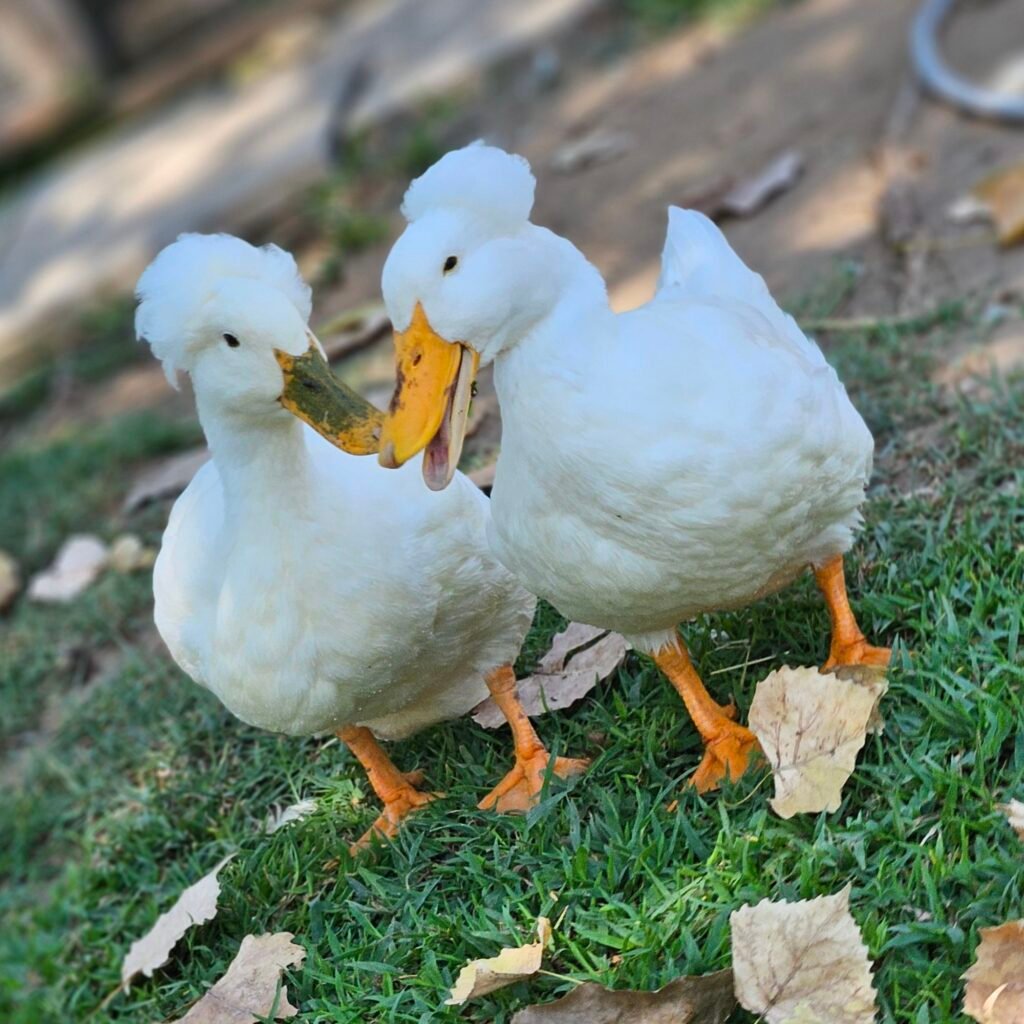
To further clarify, researchers have conducted experiments to test this myth. They found that the unique characteristics of duck quacks, including their specific frequency patterns, can indeed produce echoes under the right conditions. So, the next time you hear a duck quacking, remember that it can echo just like any other sound!
Why Some Ducks Don’t Quack Much
Not all ducks are vocal, and you might notice that some breeds or individual ducks are significantly quieter than their more boisterous companions. There are several factors at play that can influence a duck’s vocalizations, and understanding these can provide valuable insights for any duck parent.
Personality and Temperament
Just like humans, ducks have unique personalities. Some ducks are naturally more reserved and may not feel the need to vocalize as frequently. This quieter disposition can vary from duck to duck, and some may prefer to communicate through body language rather than vocal sounds. If you have a duck that tends to stay more in the background, she may simply be less inclined to quack often.
Breed Differences
Different duck breeds have varying vocalization habits. For instance, Indian Runner Ducks are known for being relatively quiet, while Pekins are often quite chatty. Understanding the specific vocal tendencies of each breed can help set your expectations and help you appreciate the diversity within your flock. Breeds like the Muscovy Duck, which is a different species entirely, are known for their quieter demeanor and often communicate with low grunts rather than loud quacks.

Health Considerations
A duck’s health can also impact its vocalization. If a duck is feeling unwell or stressed, it may become less vocal. Conditions such as respiratory issues, pain, or anxiety can all lead to a decrease in quacking. It’s essential for duck parents to monitor their flock for any changes in vocalization patterns, as this could be an indicator of underlying health concerns.
➡️ Learn about the most common health issues in ducks.
Environmental Influences
Finally, the environment plays a significant role in duck vocalization. Ducks that are kept in quieter settings with less stimulation may not feel the need to quack as much. Conversely, ducks that are exposed to lively environments with other animals or noises may be more inclined to vocalize frequently. Additionally, if a duck feels threatened or insecure, it might choose to remain silent to avoid drawing attention to itself.
Final Thoughts
Ducks are more than just quackers—they’re expert communicators with a variety of sounds that reflect their emotions, social interactions, and instincts. From the playful chatty quacks to the proud egg song, each quack holds a meaning. Female ducks, in particular, are the vocal leaders of the flock, using everything from soothing motherly coos to frantic warning calls to keep their family and flock safe.
With time and experience, you’ll learn to recognize the unique voice of each duck, and may even pick up on their “duck dialects” if you have a large or mixed flock! Understanding your ducks’ vocalizations will help you connect with them on a deeper level and appreciate the many ways they express themselves.
So, next time you hear your ducks quacking, take a moment to listen closely—what might they be telling you? Can you recognize each of your ducks by their quacks? Let us know in the comments below!



